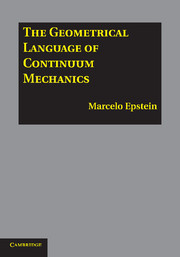1 - The Case for Differential Geometry
Published online by Cambridge University Press: 05 August 2011
Summary
If Mathematics is the language of Physics, then the case for the use of Differential Geometry in Mechanics needs hardly any advocacy. The very arena of mechanical phenomena is the space-time continuum, and a continuum is another word for a differentiable manifold. Roughly speaking, this foundational notion of Differential Geometry entails an entity that can support smooth fields, the physical nature of which is a matter of context. In Continuum Mechanics, as opposed to Classical Particle Mechanics, there is another continuum at play, namely, the material body. This continuous collection of particles, known also as the body manifold, supports fields such as temperature, velocity and stress, which interact with each other according to the physical laws governing the various phenomena of interest. Thus, we can appreciate how Differential Geometry provides us with the proper mathematical framework to describe the two fundamental entities of our discourse: the space-time manifold and the body manifold. But there is much more.
When Lagrange published his treatise on analytical mechanics, he was in fact creating, or at least laying the foundations of, a Geometrical Mechanics. A classical mechanical system, such as the plane double pendulum shown in Figure 1.4, has a finite number of degrees of freedom. In this example, because of the constraints imposed by the constancy of the lengths of the links, this number is 2.
- Type
- Chapter
- Information
- The Geometrical Language of Continuum Mechanics , pp. 3 - 23Publisher: Cambridge University PressPrint publication year: 2010



